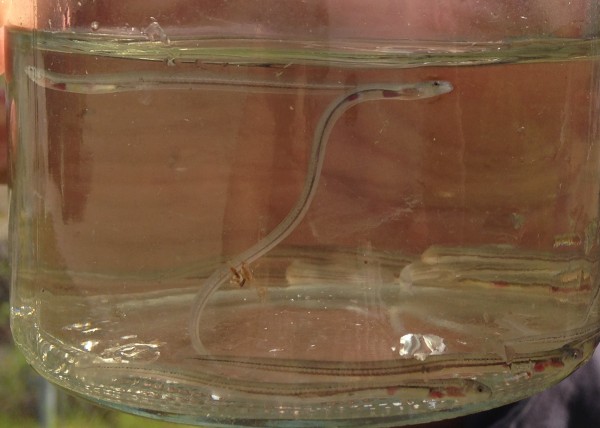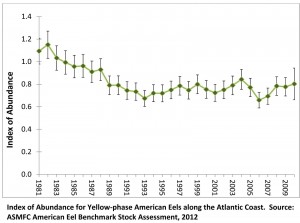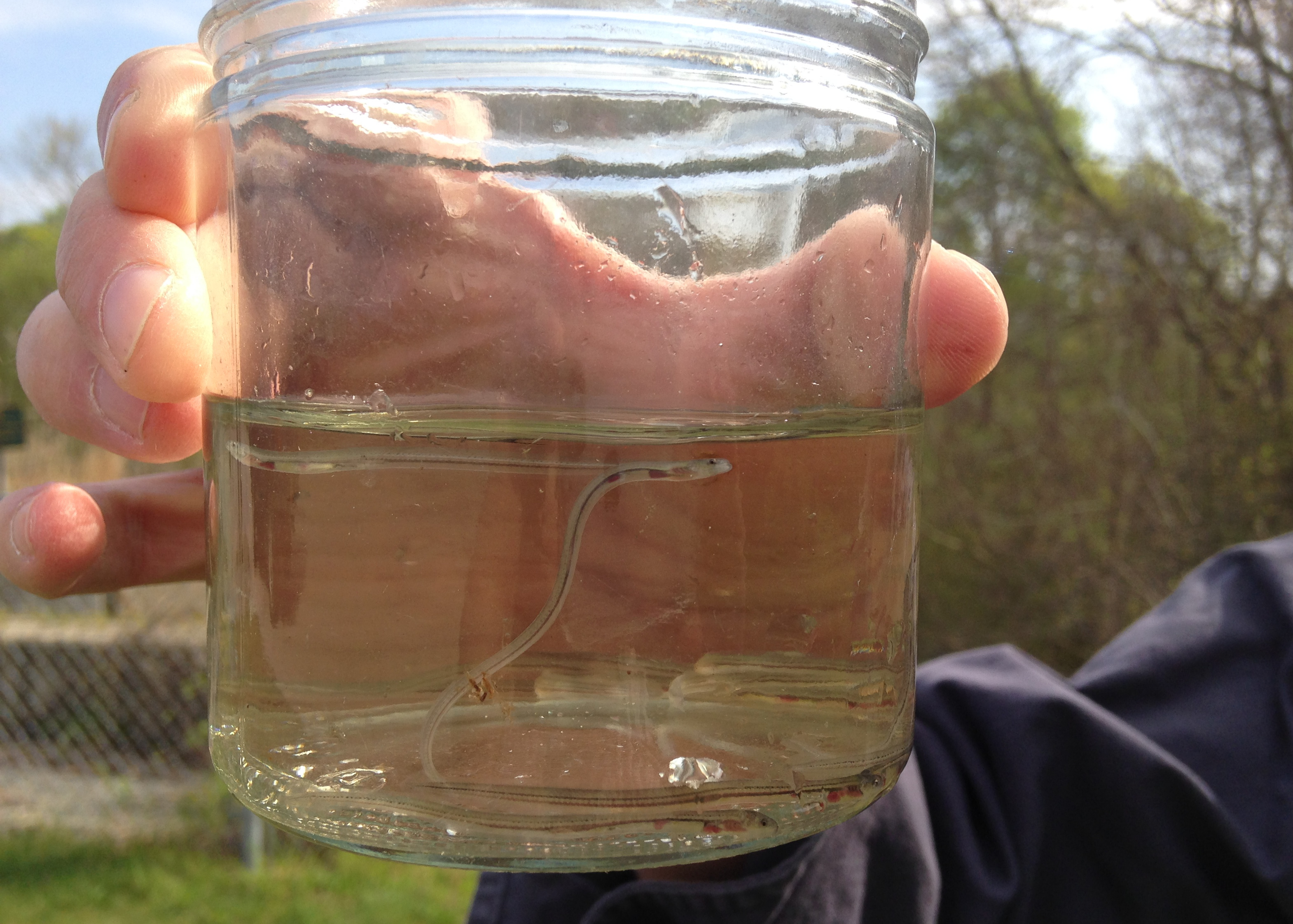
We tend to think of eels only as sushi or bait. But they are also among the most interesting, endangered and expensive fish in Rhode Island waters.
In contrast to river herring, salmon and other anadromous fish (those that live in salt water and breed in fresh water), eels are catadromous. They spend their lives in fresh water and swim out to sea to breed and then die. We know they spawn somewhere in the Sargasso Sea, a section of the Atlantic Ocean west of Bermuda. But their mating ritual remains a secret. Despite many attempts, it has never been witnessed.
The larval offspring randomly float to points all along the northwestern edge of the Atlantic – anywhere from the Caribbean islands to Canadian maritime provinces. Once they’ve reached a coastline, they make their way upriver into fresh water. For the next seven to 20 years they will live in local rivers and lakes, growing to be about two or three feet long, before secretly swimming back out to the Sargasso Sea to spawn and then die.
“It’s one of the great mysteries of the sea,” said Bob Ballou, assistant director of the state Department of Environmental Management. “These fish are amazing.”
In rivers all over Rhode Island right now, these tiny and somewhat transparent baby eels are ruthlessly swimming upstream to find a freshwater home. At this stage of their lives, smaller than 65 centimeters, they are called glass eels, and they are one of the most valuable and threatened species of fish found in New England.

Earlier this week, Ballou attended an Atlantic States Marine Fisheries Commission meeting where it moved forward in developing new interstate regulations for eels. The group will study and discuss a range of options throughout the summer, including a moratorium on glass eel harvesting. In 2011, eels were considered for protection under the Endangered Species Act.
“Eels are going to be an emerging issue,” Ballou told me. “They are going to get a lot more attention.”
Adult eels, or yellow eels, live quietly in our local lakes and rivers and are legally harvested in many states – in Rhode Island they must be at least 9 inches. But the take is very small; though eel is a delicacy in Japan, here they are used just for bait to fish for striped bass.
The glass eel harvest is another story entirely.
It is outlawed in every East Coast state except Maine and South Carolina, where they are sold and shipped to China and farmed indoors for food. “Adult eels are mostly sold in Japan where they are roasted,” according to the Boston Globe, “in the United States, sushi eaters might recognize them as unagi.”
So valuable are the tiny, transparent eels that the ASMFC and others, such as Save The Bay, are very concerned with poaching in one state to bootleg them to Maine or South Carolina. Last year, a pound of glass eels could be sold legally in Maine for $2,000.
“It was like the wild west up there,” Ballou said. “There were reports of people making $150,000 on a good night.”
Last year, at least two poachers were arrested in Rhode Island, according to this ecoRI report. Jack McIlmail, a captain in DEM’s law enforcement division, declined to provide documents relating to any arrests for eel poaching and DEM declined to discuss law enforcement actions concerning glass eels entirely. Ballou said he wasn’t aware of other arrests, and stressed that poaching hasn’t been an issue in Rhode Island. DEM does patrol for poachers though; an enforcement officer was recently at the Mattattuxet River, asking people if they have seen vehicles with Maine or South Carolina license plates.
This season in Maine the price is down to about $1,000 a pound, said Bill Quinby, an international fish broker based in South Carolina who used to business in Rhode Island waters (He coordinated the deal between the DEM and the Russian fish-buying boat in Narragansett Bay). His company Mayflower International is a licensed glass eel dealer in Maine and owns one of only ten harvest licenses in South Carolina and sells them to Chinese and Korean businesses.
There are three types of eels in the world, Quinby explained: Japanese, European and American. An earthquake decimated the Japanese eel population about six years ago and the European fishery is very heavily regulated. This set off the eel boom in Maine.
“It was shortly after the tsunami and earthquake in Japan,” he told me, “and the demand for glass eels for aquaculture in China, particularly, escalated tremendously because they used to get their baby eels from Japan and grow them out for market.”
Dealers would drive around with carloads of cash, Quinby confirmed, and trade Maine fishermen tens of thousands of dollars for their glass eel catch. This year, Maine instituted a quota of 11,000 pounds and transactions are now done with a swipe card.
Save The Bay Baykeeper Tom Kutcher said Maine instituted the quota knowing the ASMFC would be putting new regulations in place. “It’s irresponsible management to let it go on,” he said. “It’s really good pay for really irresponsible work.”
Save The Bay would like to see the ASMFC put a moratorium on all glass eel harvesting. “They are undergoing this incredible decline,” Kutcher said. “At one time they were the highest biomass fish in our rivers.”
Ballou, who is a member of ASMFC American Eel Advisory Board, said there may be room for harvesting a small number of glass eels in Rhode Island someday.
“There is a school of thought out there that if we could do it in a sustainable way, if you had a facility to grow out these eels,” he said. “You could argue that you’d actually get more protection for the resource by capturing some with some sort of innovative approach. It could be beneficial to the resource and have commercial value.”

